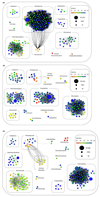Microbial eukaryote plankton communities of high-mountain lakes from three continents exhibit strong biogeographic patterns
- PMID: 27029537
- PMCID: PMC4976798
- DOI: 10.1111/mec.13633
Microbial eukaryote plankton communities of high-mountain lakes from three continents exhibit strong biogeographic patterns
Abstract
Microbial eukaryotes hold a key role in aquatic ecosystem functioning. Yet, their diversity in freshwater lakes, particularly in high-mountain lakes, is relatively unknown compared with the marine environment. Low nutrient availability, low water temperature and high ultraviolet radiation make most high-mountain lakes extremely challenging habitats for life and require specific molecular and physiological adaptations. We therefore expected that these ecosystems support a plankton diversity that differs notably from other freshwater lakes. In addition, we hypothesized that the communities under study exhibit geographic structuring. Our rationale was that geographic dispersal of small-sized eukaryotes in high-mountain lakes over continental distances seems difficult. We analysed hypervariable V4 fragments of the SSU rRNA gene to compare the genetic microbial eukaryote diversity in high-mountain lakes located in the European Alps, the Chilean Altiplano and the Ethiopian Bale Mountains. Microbial eukaryotes were not globally distributed corroborating patterns found for bacteria, multicellular animals and plants. Instead, the plankton community composition emerged as a highly specific fingerprint of a geographic region even on higher taxonomic levels. The intraregional heterogeneity of the investigated lakes was mirrored in shifts in microbial eukaryote community structure, which, however, was much less pronounced compared with interregional beta-diversity. Statistical analyses revealed that on a regional scale, environmental factors are strong predictors for plankton community structures in high-mountain lakes. While on long-distance scales (>10 000 km), isolation by distance is the most plausible scenario, on intermediate scales (up to 6000 km), both contemporary environmental factors and historical contingencies interact to shift plankton community structures.
Keywords: alpine lakes; biogeography; diversity; fungi; next-generation sequencing; protistan plankton.
© 2016 John Wiley & Sons Ltd.
Figures






Similar articles
-
High diversity of protistan plankton communities in remote high mountain lakes in the European Alps and the Himalayan mountains.FEMS Microbiol Ecol. 2015 Apr;91(4):fiv010. doi: 10.1093/femsec/fiv010. Epub 2015 Jan 27. FEMS Microbiol Ecol. 2015. PMID: 25764458 Free PMC article.
-
Genetic diversity of eukaryotic plankton assemblages in Eastern Tibetan Lakes differing by their salinity and altitude.Microb Ecol. 2009 Oct;58(3):569-81. doi: 10.1007/s00248-009-9526-8. Epub 2009 May 16. Microb Ecol. 2009. PMID: 19444496 Free PMC article.
-
Genetic diversity of planktonic eukaryotes in high mountain lakes (Central Pyrenees, Spain).Environ Microbiol. 2012 Sep;14(9):2445-56. doi: 10.1111/j.1462-2920.2012.02797.x. Epub 2012 Jun 5. Environ Microbiol. 2012. PMID: 22672082
-
High genetic diversity and novelty in eukaryotic plankton assemblages inhabiting saline lakes in the Qaidam basin.PLoS One. 2014 Nov 17;9(11):e112812. doi: 10.1371/journal.pone.0112812. eCollection 2014. PLoS One. 2014. PMID: 25401703 Free PMC article.
-
Overview of freshwater microbial eukaryotes diversity: a first analysis of publicly available metabarcoding data.FEMS Microbiol Ecol. 2017 Apr 1;93(4). doi: 10.1093/femsec/fix023. FEMS Microbiol Ecol. 2017. PMID: 28334157
Cited by
-
Taxonomic composition, community structure and molecular novelty of microeukaryotes in a temperate oligomesotrophic lake as revealed by metabarcoding.Sci Rep. 2023 Feb 22;13(1):3119. doi: 10.1038/s41598-023-30228-4. Sci Rep. 2023. PMID: 36813945 Free PMC article.
-
Salinity Is a Key Determinant for the Microeukaryotic Community in Lake Ecosystems of the Inner Mongolia Plateau, China.Front Microbiol. 2022 Apr 12;13:841686. doi: 10.3389/fmicb.2022.841686. eCollection 2022. Front Microbiol. 2022. PMID: 35495662 Free PMC article.
-
Ciliate diversity in rodrigo de freitas lagoon (Rio de Janeiro, Brazil) from an integrative standpoint.Braz J Microbiol. 2024 Jun;55(2):1489-1505. doi: 10.1007/s42770-024-01291-4. Epub 2024 Feb 24. Braz J Microbiol. 2024. PMID: 38401009 Free PMC article.
-
Effects of natural vegetative restoration on soil fungal and bacterial communities in bare patches of the southern Taihang Mountains.Ecol Evol. 2019 Aug 16;9(18):10432-10441. doi: 10.1002/ece3.5564. eCollection 2019 Sep. Ecol Evol. 2019. PMID: 31624558 Free PMC article.
-
Bacterioplankton composition in tropical high-elevation lakes of the Andean plateau.FEMS Microbiol Ecol. 2018 Mar 1;94(3):fiy004. doi: 10.1093/femsec/fiy004. FEMS Microbiol Ecol. 2018. PMID: 29346530 Free PMC article.
References
-
- Alexander E, Stock A, Breiner HW, et al. Microbial eukaryotes in the hypersaline anoxic L’Atalante deep-sea basin. Environmental Microbiology. 2009;11:360–381. - PubMed
-
- Altschul SF, Gish W, Miller W, Myers EW, Lipman DJ. Basic local alignment search tool. Journal of Molecular Biology. 1990;215:403–410. - PubMed
-
- Atkinson KM. Further experiments in dispersal of phytoplankton by birds. Wildfowl. 1971;22:98–99.
-
- Auguet JC, Barberán A, Casamayor EO. Global ecological patterns in uncultured Archaea. The ISME Journal. 2010;4:182–190. - PubMed
Publication types
MeSH terms
Associated data
- Actions
Grants and funding
LinkOut - more resources
Full Text Sources
Other Literature Sources

